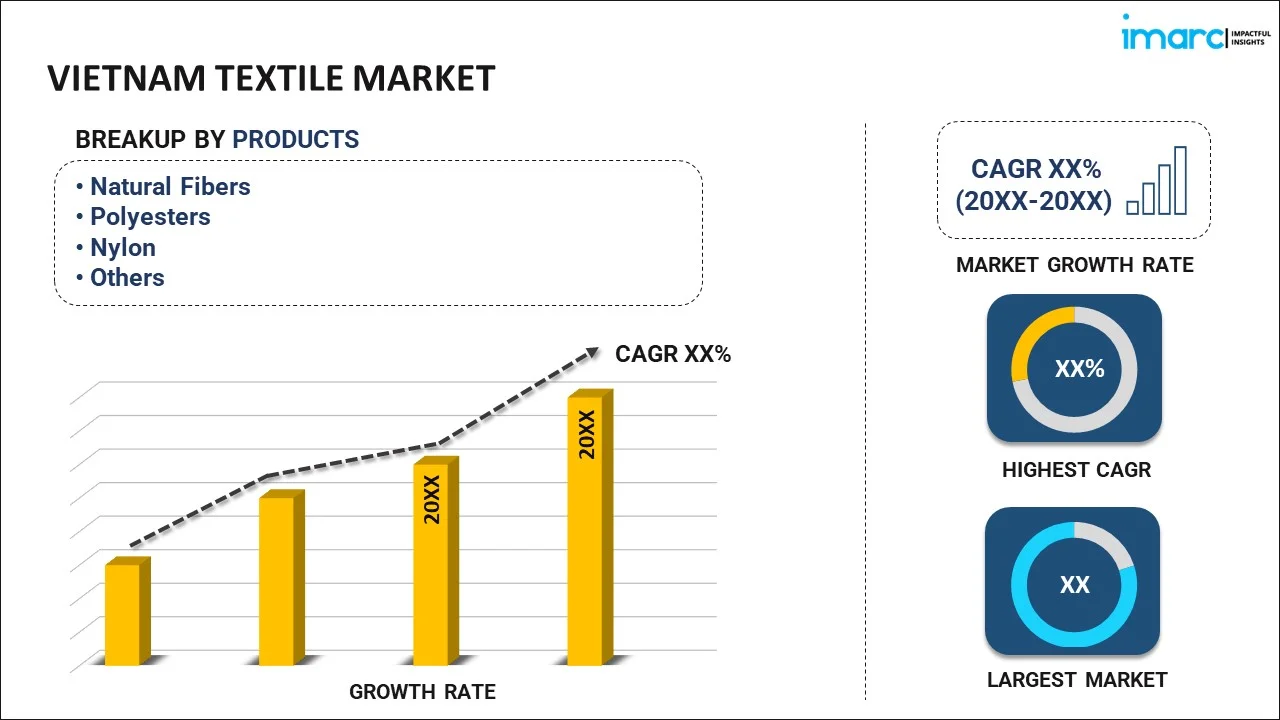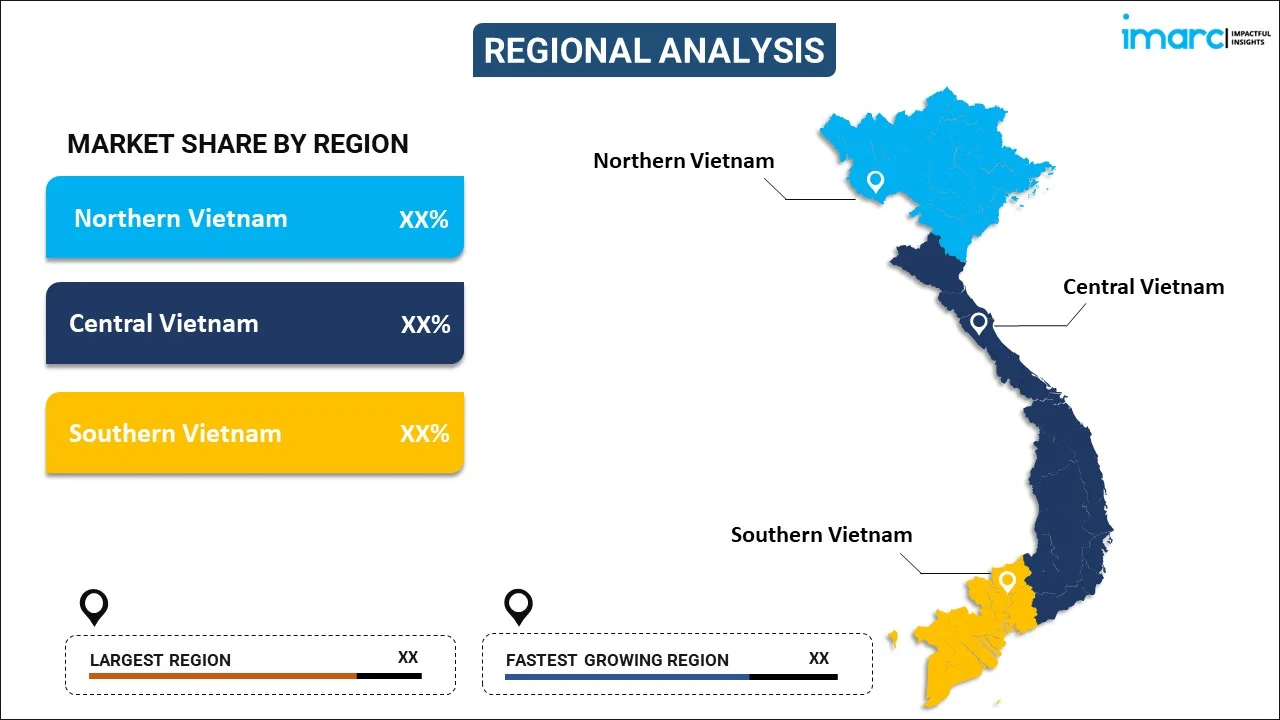
Vietnam Textile Market Report by Product (Natural Fibers, Polyesters, Nylon, and Others), Raw Material (Cotton, Chemical, Wool, Silk, and Others), Application (Household, Technical, Fashion and Clothing, and Others), and Region 2025-2033
Market Overview:
Vietnam textile market size reached USD 17.3 Billion in 2024. Looking forward, IMARC Group expects the market to reach USD 26.3 Billion by 2033, exhibiting a growth rate (CAGR) of 4.4% during 2025-2033. The growing emphasis on using recycled materials, rising use of Industry 4.0 technologies, and increasing innovation in performance textiles and the production of textiles with moisture-wicking, ultraviolet (UV) protection, and antimicrobial properties represent some of the key factors driving the market.
|
Report Attribute
|
Key Statistics
|
|---|---|
|
Base Year
|
2024
|
|
Forecast Years
|
2025-2033
|
|
Historical Years
|
2019-2024
|
|
Market Size in 2024
|
USD 17.3 Billion |
|
Market Forecast in 2033
|
USD 26.3 Billion |
| Market Growth Rate 2025-2033 | 4.4% |
Textile refers to any material made up of interlocking fibers like cotton, wool, silk, or linen. It comprises different types of weaving and knitting patterns to create varying textures and structures. It also undergoes various finishing treatments like dyeing, printing, and glazing to alter its appearance and performance. It includes natural textiles like cotton, wool, silk, linen, and hemp and synthetic textiles, such as polyester, nylon, acrylic, and spandex. It also consists of specialty textiles like fire-resistant, waterproof, and anti-microbial textiles that are tailored for specific applications. It varies in weight and thickness, making it suitable for different purposes. It often plays a vital role in expressing cultural heritage through traditional clothing and crafts. It is crucial for producing protective gear and ensuring safety in various industries. It can improve the daily lives of people by providing comfort and style in clothing and home furnishings. It can also be tailored to suit various applications, from casual wear to technical uses. It is often utilized to manufacture various home furnishing elements, such as bedding, curtains, upholstery, and carpets. It is also employed in manufacturing products like filters, ropes, tents, and covers.
Vietnam Textile Market Trends:
At present, the increasing emphasis on using recycled materials, adopting eco-friendly production processes, and promoting circular fashion concepts to extend the lifespan of textiles represents one of the crucial factors impelling the growth of the market in Vietnam. Besides this, the rising use of Industry 4.0 technologies, such as automation, data analytics, and the Internet of Things (IoT), for streamlining supply chains, enhancing production efficiency, and enabling customization and personalization in textile products is contributing to the market growth in the country. In addition, the growing influence of digital platforms and e-commerce in transforming the way textiles are marketed and sold, enabling global reach and improving the overall customer experience is offering a favorable market outlook. Apart from this, health consciousness among people is driving the demand for activewear and athleisure segments, encouraging innovation in performance textiles and the production of textiles with moisture-wicking, ultraviolet (UV) protection, and antimicrobial properties. Rapid changes in fashion preferences and consumer tastes are encouraging textile manufacturers to be agile and responsive in developing new designs and materials. Fast fashion and the rise of social media are also accelerating the pace at which trends emerge and fade. Additionally, the rising adoption of stringent regulations and certification programs, such as those related to chemical restrictions and organic labeling, is improving the production processes, sourcing decisions, and consumer trust in textile products.
Vietnam Textile Market Segmentation:
IMARC Group provides an analysis of the key trends in each segment of the market, along with forecasts at the country level for 2025-2033. Our report has categorized the market based on product, raw material, and application.
Product Insights:

- Natural Fibers
- Polyesters
- Nylon
- Others
The report has provided a detailed breakup and analysis of the market based on the product. This includes natural fibers, polyesters, nylon, and others.
Raw Material Insights:
- Cotton
- Chemical
- Wool
- Silk
- Others
A detailed breakup and analysis of the market based on the raw material have also been provided in the report. This includes cotton, chemical, wool, silk, and others.
Application Insights:
- Household
- Technical
- Fashion and Clothing
- Others
The report has provided a detailed breakup and analysis of the market based on the application. This includes household, technical, fashion and clothing, and others.
Regional Insights:

- Northern Vietnam
- Central Vietnam
- Southern Vietnam
The report has also provided a comprehensive analysis of all the major regional markets, which include Northern Vietnam, Central Vietnam, and Southern Vietnam.
Competitive Landscape:
The market research report has also provided a comprehensive analysis of the competitive landscape in the market. Competitive analysis such as market structure, key player positioning, top winning strategies, competitive dashboard, and company evaluation quadrant has been covered in the report. Also, detailed profiles of all major companies have been provided.
Vietnam Textile Market Report Coverage:
| Report Features | Details |
|---|---|
| Base Year of the Analysis | 2024 |
| Historical Period | 2019-2024 |
| Forecast Period | 2025-2033 |
| Units | Billion USD |
| Scope of the Report | Exploration of Historical and Forecast Trends, Industry Catalysts and Challenges, Segment-Wise Historical and Predictive Market Assessment:
|
| Products Covered | Natural Fibers, Polyesters, Nylon, Others |
| Raw Materials Covered | Cotton, Chemical, Wool, Silk, Others |
| Applications Covered | Household, Technical, Fashion and Clothing, Others |
| Regions Covered | Northern Vietnam, Central Vietnam, Southern Vietnam |
| Customization Scope | 10% Free Customization |
| Post-Sale Analyst Support | 10-12 Weeks |
| Delivery Format | PDF and Excel through Email (We can also provide the editable version of the report in PPT/Word format on special request) |
Key Questions Answered in This Report:
- How has the Vietnam textile market performed so far and how will it perform in the coming years?
- What has been the impact of COVID-19 on the Vietnam textile market?
- What is the breakup of the Vietnam textile market on the basis of product?
- What is the breakup of the Vietnam textile market on the basis of raw material?
- What is the breakup of the Vietnam textile market on the basis of application?
- What are the various stages in the value chain of the Vietnam textile market?
- What are the key driving factors and challenges in the Vietnam textile?
- What is the structure of the Vietnam textile market and who are the key players?
- What is the degree of competition in the Vietnam textile market?
Key Benefits for Stakeholders:
- IMARC’s industry report offers a comprehensive quantitative analysis of various market segments, historical and current market trends, market forecasts, and dynamics of the Vietnam textile market from 2019-2033.
- The research report provides the latest information on the market drivers, challenges, and opportunities in the Vietnam textile market.
- Porter's five forces analysis assist stakeholders in assessing the impact of new entrants, competitive rivalry, supplier power, buyer power, and the threat of substitution. It helps stakeholders to analyze the level of competition within the Vietnam textile industry and its attractiveness.
- Competitive landscape allows stakeholders to understand their competitive environment and provides an insight into the current positions of key players in the market.
Need more help?
- Speak to our experienced analysts for insights on the current market scenarios.
- Include additional segments and countries to customize the report as per your requirement.
- Gain an unparalleled competitive advantage in your domain by understanding how to utilize the report and positively impacting your operations and revenue.
- For further assistance, please connect with our analysts.
 Inquire Before Buying
Inquire Before Buying
 Speak to an Analyst
Speak to an Analyst
 Request Brochure
Request Brochure
 Request Customization
Request Customization




.webp)




.webp)












